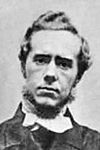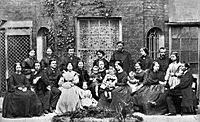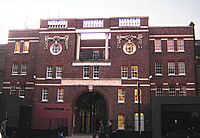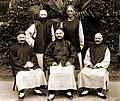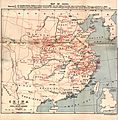OMF International facts for kids
 |
|
| Formation | 25 June 1865 |
|---|---|
| Founder | Hudson Taylor |
| Type | Evangelical Missions Agency |
| Focus | Unreached People Groups, discipleship, church planting |
| Headquarters | Shanghai (formerly) Singapore (1950s-Present) |
| Location | |
| Origins | China Inland Mission (till 1964) |
|
Area served
|
East Asia & East Asians globally |
|
Key people
|
Hudson Taylor, DE Hoste, JO Fraser, A.J. Broomhall, Patrick Fung, Cambridge Seven, |
| Website | https://omf.org |
|
Formerly called
|
China Inland Mission |
OMF International is a Christian group that sends people, called missionaries, to share their faith in East Asia. It was started in Britain by a man named Hudson Taylor on June 25, 1865. At first, it was called the China Inland Mission. Later, its name changed to the Overseas Missionary Fellowship before becoming OMF International.
The group is interdenominational, which means it includes people from many different Christian church groups. Its main office is in Singapore.
Contents
What is OMF International?
The China Inland Mission (CIM) was started by Hudson Taylor with the goal of bringing the Christian message to all of China. He believed in praying for help and trusting that God would provide what the mission needed.
The mission was special because it welcomed missionaries from all backgrounds, including working-class people and single women, which was unusual at the time. The main goal was to share the Gospel (the Christian message) with people in East Asia.
In the early 1950s, all foreign workers had to leave China. The CIM then sent its missionaries to other countries in East Asia. In 1964, the name was changed to the Overseas Missionary Fellowship, and later to OMF International in the 1990s.
The History of the Mission
How It All Began
Hudson Taylor decided to start the China Inland Mission while he was back in England from China. He believed that missionaries should live like the local people to better connect with them. This included wearing Chinese clothes.
In 1865, he sent the first few missionaries to China. The next year, on May 26, 1866, Taylor and his family sailed to China with a large group of 16 missionaries. This group became known as the Lammermuir Party, named after the ship they traveled on. The journey took four long months.
Exploring Inland China
In 1872, the mission set up a council in London to help manage its work. By 1875, they began a plan to reach all of China. Taylor prayed for more workers, and many people answered the call. In 1887, a famous group called "The Hundred missionaries" was sent to China.
The mission became well-known around the world. People admired the missionaries because they were humble and willing to live in difficult conditions to help others. A training home for women missionaries was also set up in London, preparing hundreds for their work.
The Boxer Rebellion in 1900
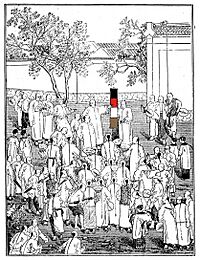
In 1900, a violent movement known as the Boxer Rebellion swept across China. The Boxers targeted foreigners and Chinese Christians. During this time, the China Inland Mission suffered greatly, losing 58 adult missionaries and 21 of their children.
After the rebellion, other countries demanded money from China as compensation for the damages. However, Hudson Taylor refused to accept any money for the mission's losses. He wanted to show the Chinese people the Christian value of forgiveness.
Growth During Times of Change
The early 1900s were a time of great change in China, including the fall of the emperor and the creation of the Chinese Republic. Despite the dangers, missionary work grew.
One famous missionary was James O. Fraser, who brought the Christian message to the Lisu people in southwest China. His work led to a large and lasting Christian community among the tribes in that area.
The 1930s and 1940s were also dangerous times because of wars. A young missionary couple, John and Betty Stam, were killed in 1934. Their story inspired many others to become missionaries. During World War II, when Japan invaded China, many missionaries were captured and held in camps until the war ended.
Despite these hardships, the number of Christians in China grew from about 100,000 in 1900 to 700,000 by 1950.
From China to the World
After the Chinese Communist Revolution in 1949, all foreign missionaries had to leave China. The leaders of the mission decided to send their workers to other parts of East Asia. The headquarters moved to Singapore, and new work began in countries like Japan, Taiwan, the Philippines, and Thailand.
The mission's work expanded. They helped create written languages for some tribal groups, translated the Bible, and provided education. They also started medical work, opening hospitals in rural Thailand and community programs in the Philippines.
In 2006, Dr. Patrick Fung became the first Asian leader of the mission. Today, OMF International continues its work around the world.
The Old London Headquarters
The original headquarters of the China Inland Mission was in Newington Green, a neighborhood in North London. The building is still there today and is now known as Alliance House. It is used as a dormitory for university students.
A Timeline of Key Events
- 1865: The China Inland Mission is founded by Hudson Taylor.
- 1866: The "Lammermuir Party," a large group of missionaries, sails for China.
- 1887: "The Hundred Missionaries" are sent to China in a single year.
- 1900: The Boxer Rebellion leads to the deaths of many missionaries and Chinese Christians.
- 1912: The mission has over 1,000 workers, making it the largest mission in China.
- 1934: Missionaries John and Betty Stam are killed, inspiring a new generation of workers.
- 1951: Missionaries leave China and are sent to other East Asian countries. The headquarters moves to Singapore.
- 1964: The name is changed to the Overseas Missionary Fellowship (OMF).
- 1990s: The name is changed again to OMF International.
- 2006: Dr. Patrick Fung becomes the first Asian General Director of the mission.
- 2015: OMF celebrates its 150th anniversary.
Images for kids
See also
- Hudson Taylor
- Cambridge Seven
- James O. Fraser
- School of Oriental and African Studies in London
Archives
The historical papers of the China Inland Mission are kept in several places, including SOAS Archives in London, the Billy Graham Center at Wheaton College in the U.S., and the OMF International Center in Singapore.
Selected publications
LONDON : MORGAN AND SCOTT, 12, PATERNOSTER BUILDINGS, E.C. Original from the New York Public Library Digitized Aug 15, 2006.
(Princeton University)


